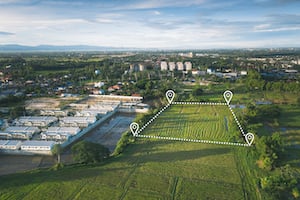Buying Land: 10 Keys for Successful Site Selection & Land Acquisition
Not all vacant land is the same. From dense urban infill sites to “land cover plays” to large swaths of farmland. Land acquisition is full of risk and can be a convoluted process laden with bureaucratic complexities.
The process of acquiring land is as much an art form as it is a science. It’s a type of commercial real estate transaction vastly different from its counterparts, and thus follows a much different formula for success.
Our failures and successes as both an advisor and principal on land acquisitions for residential development, industrial and corporate build-to-suit projects, and speculative investment, have helped shape our understanding of the process. We’ve distilled all of our lessons learned into 10 keys for successful site selection and land acquisition:
1. Determine your goal
There is a concept in process management known as backward planning or backward design. It’s the notion that when you plan in reverse, you start with your end goal and work backward to develop a plan of action.
A set of requirements drives every land acquisition. And these requirements ultimately inform your site selection search.
Maybe you’re an investor that’s looking to capitalize on long-term growth and value appreciation. Or you’re a developer serving a build-to-suit client who is ultimately dictating the project's requirements. Or you're a business owner that is buying a site to develop and construct a building to occupy eventually.
The point is, depending on your preferred end state, each project will determine a unique set of requirements, which need to be overlayed across available land options. And the site search should begin there – it needs to be broad and overarching.
Trying to force a site to meet your requirements will inevitably lead to obstacles and disappointment.
2. Where is the growth headed?
By the time dense development has already reached an area, it may be too late. The land is scarcer, so that’s often reflected in heftier price tags, and municipalities are generally less inclined to play ball after an area has been built up.
Anticipating horizontal growth trends and getting ahead of human migration patterns is vital to capturing greater value appreciation. It's also crucial for businesses whose growth is driven by factors like location, proximity to talent pools, or demographic segmentation.
Traditionally, planners and developers have attempted to distill urban and suburban growth into observable hypotheses. Theories like the concentric circle theory or the theory of multiple nuclei postulate that the natural life cycle of development follows a predictable multi-year, initial to final growth stage process.
But those explanations fail to account for the introduction of disruptive technologies, like the universal accessibility of automobiles or the rise of e-commerce. They also fail to account for evolving human preferences – especially those developed from once-in-a-generation events like COVID-19 or the ensuing government lockdowns.
Today, migration patterns are evolving more quickly than we’ve seen since the industrial revolution. Before you consider a land acquisition, you need to understand how growth is changing and how those changes may impact the success of your project.
3. Consider highest and best use
Highest and best use is a concept originally used by real estate appraisers that helps to articulate a property's maximum value. It essentially equates economic utility with what is legally, financially, and physically feasible on a site.
This is important to the land acquisition process for several reasons.
First, although highest and best is a derivative of economic utility for the specific individual landowner, the progression of community growth also dictates what a site can yield.
For instance, a site conducive to long-term appreciation may not be adequate for a location-agnostic manufacturer that needs 5-acres of laydown yard. Just as an infill lot perfect for mixed-use or multifamily products probably isn't the right fit for sparse single-family homes – even if those outcomes achieve more economic utility for a specific individual.
Central planning may also dictate the highest and best use, which can be informed by a municipality's future land use map. Local governments often have future land use designations that indicate the general allowable development and density of a particular area.
Understanding a site’s highest and best use, even in areas of low growth that have yet to fall victim to urban sprawl, will help you achieve value through land acquisition that others won’t.
4. Environmental considerations
Even if the property isn’t the location of an old gas station or a publicly acknowledged brownfield site doesn’t mean it’s not subject to environmental considerations. Large parcel agricultural land can even pose a severe clean-up problem - and in the case of land acquisitions, once you own the ground, you're on the hook for it.
At a minimum, a phase I environmental assessment should be conducted, and, in some cases, a phase II assessment may be necessary. Understanding the environmental risks associated with a property before you buy it is critical to the success of your project.
An environmental assessment will evaluate the likelihood of any site contamination, identify wells or possible underground storage tanks, and assess potential adverse environmental impacts from adjacent land. And any problems revealed during site due diligence will often be the owner’s problem.
A thorough environmental investigation is critical to the land acquisition and site selection process as both a risk mitigation measure and barometer of economic feasibility.
5. Municipal considerations
Zoning requirements, easements, stormwater regulations, necessary setbacks, tree conservation, open space requirements, and improvements to rights-of-way – they’re all examples of local ordinances that could impact a project. And often result in additional time considerations and can add hundreds of thousands of dollars to a development budget.
Every municipality has its own set of rules and guidelines governing land use and development. And depending on your goals and desired end state, you’ll be subject to a series of project-dependent guidelines.
It would be unrealistic to learn every applicable code, inside and out, though. Developers, land-use attorneys, and engineers make a living dealing with these complexities. But understanding they exist and enlisting the right folks to help you navigate them is an essential aspect of land acquisition and site due diligence.
Accurate development budgets are vital to assessing a project’s feasibility. And unfamiliarity with municipal regulations or hiring the wrong team to help is the quickest path to an unsuccessful project.
6. Identify needed site work
It’s easy to walk a site and assess its topography. But a site’s slope is only one aspect of development – not all site work is readily apparent.
Is a stream considered a stream, or is it considered stormwater run-off? To the naked eye, the difference is negligible, but to the feasibility of a project, it can be a deal-breaker. In one case, you might not be able to build, and in the other, you might be able to pipe it and continue development.
From identifying a site's access to utilities (city sewer and water) and conducting soil studies to assessing the need for a stormwater collection device or retaining wall, no aspect of site work is too minute to consider. Experienced developers will attest that unexpected site work fees add up and can derail a project that's underway.
In the case of identifying necessary site work, an experienced civil engineer can be your best friend. Before you close a land acquisition, you should hire an engineer, develop a comprehensive site plan, and understand the work required to develop the land.
7. Plan several exit opportunities
If you're buying land on the path of community growth and don't need steady cash flow, it offers a highly appreciable asset with little maintenance costs. The economic law of scarcity also drives demand and value appreciation.
With that said, land investing is typically highly speculative - it often doesn’t generate any positive cash flow and may take years to see any substantial capital gains. It’s less liquid than traditional real estate, is subject to a longer transaction cycle, and future use restrictions may impact its present value.
As part of your land acquisition due diligence and comprehensive business plan, you should leave yourself several exit opportunities.
For instance, let’s assume you’re a small business planning to develop a site for a new headquarters. You've analyzed your company's growth and acquired a feasible location to accommodate your space needs. But an unforeseen economic disruption in your industry has changed your future outlook. If you bought a site an hour from the nearest MSA, you might be out of luck to quickly re-sell the property.
Or consider a developer who plans to develop and hold an apartment complex following construction. But rising building costs have the developer concerned they won’t make money on the project’s construction. Instead, the developer could entitle the land and sell the site to a builder whose business model revolves around construction – someone who can acquire inputs at cost and leverage economies of scale.
8. If you don’t have experience with land acquisitions – work with a land broker
If it’s not already apparent, buying land is a nuanced process. And depending on your project, the contingent steps and maze of government codes can be overwhelming.
Land brokers are experienced in all aspects of the land acquisition process – from conducting their own due diligence to asking the right questions for their clients. Until you have several land purchases under your belt, you don’t know what you don’t know.
Land brokers are often much more articulate in land use and zoning matters, and they can even help navigate the land loan financing process. Most land brokers are also adept at leveraging satellite imagery, aerial maps, and municipal resources to assist with the due diligence process.
9. Get to know the owner
Getting to know the individual on the other side of the negotiation table is a good practice anyway. But even more so than most other types of commercial real estate transactions, land acquisition is a war of attrition – a balance between sheer persistence and emotional intelligence.
Landowners are often driven by a different set of motivations than other real estate owners. Sometimes, land has been in a single family for generations, and it’s become a part of the family. Farmers are often concerned by more than just money and may want some say in the future use of the land.
Extended living room meetings are not uncommon when negotiating a land acquisition. Be genuine, really get to know the owner, and take their concerns and conditions to heart. A good faith, amicable negotiation often results in a much higher rate of success.
10. Have a solid plan for financing
Financing a land acquisition is much different from applying for a traditional mortgage. The terms and type of financing will be primarily driven by the proposed land use and type of project.
Lenders need to feel comfortable that a site can accommodate your proposed project. They’ll need extensive due diligence materials and typically need more time to underwrite a project to achieve that comfortability. Additionally, even if you have a rock-solid development plan in place, the required down payment may be 25%-30% or higher.
If you’re acquiring land as a speculative investment, you should expect to outlay at least 50% of the purchase price. And that’s if a bank even lends on a spec project.
If you take the conventional financing route, begin conversations with a lender early, keep them informed throughout the process, and craft as compelling a narrative as possible.
If you decide to take an alternative approach, joint ventures and seller financing are creative financing options that can help circumvent traditional lending sources. But whatever the source, a solid plan for financing is critical to successful land acquisition.
How does a strategic real estate advisor fit in?
Any real estate strategy must be carefully crafted and refined to ensure the highest probability of success.
From site selection to helping you navigate municipal hurdles to the physical development of the land - because of the complexities of the process, it's critical to have a trusted advisor on your team – someone with experience as both an investor and developer in a variety of projects.
If you are currently navigating the land acquisition process or are thinking about undertaking a project, and have questions, let’s chat. Marsh & Partners and our real estate consulting services can help connect the dots for you.



